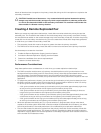
blocks of data that have changed on the primary virtual disk during the link interruption are copied to the
secondary virtual disk.
CAUTION: Possible loss of data access – Any communication disruptions between the primary
storage array and the secondary storage array while resynchronization is underway could result
in a mix of new data and old data on the secondary virtual disk. This condition would render the
data unusable in a disaster recovery situation.
Creating A Remote Replicated Pair
Before you create any replication relationships, virtual disks must exist at both the primary site and the
secondary site. The virtual disk that resides on the local storage array is the primary virtual disk. Similarly,
the virtual disk that resides on the remote storage array is the secondary virtual disk. If neither the primary
virtual disk nor the secondary virtual disk exist, you must create these virtual disks. Keep these guidelines
in mind when you create the secondary virtual disk:
• The secondary virtual disk must be of equal or greater size than the primary virtual disk.
• The RAID level of the secondary virtual disk does not have to be the same as the primary virtual disk.
Use these steps to create the virtual disk.
1. Enable the Remote Replication (legacy) premium feature.
2. Activate the Remote Replication (legacy) premium feature.
3. Determine candidates for a remote replicated pair.
4. Create the remote relationship.
Performance Considerations
Keep these performance considerations in mind when you create replication relationships:
• The RAID controller module owner of a primary virtual disk performs a full synchronization in the
background while processing local I/O writes to the primary virtual disk and associated remote writes
to the secondary virtual disk. Because the full synchronization diverts RAID controller module
processing resources from I/O writes, full synchronization can have a performance impact to the host
application.
• To reduce the performance impact, you can set the synchronization priority level to determine how
the RAID controller module owner will prioritize the full synchronization relative to other I/O activity.
To set the synchronization priority level, consider these guidelines:
– A full synchronization at the lowest synchronization priority level takes approximately eight times
as long as a full synchronization at the highest synchronization priority level.
– A full synchronization at the low synchronization priority level takes approximately six times as
long as a full synchronization at the highest synchronization priority level.
– A full synchronization at the medium synchronization priority level takes approximately three-and-
a-half times as long as a full synchronization at the highest synchronization priority level.
– A full synchronization at the high synchronization priority level takes approximately twice as long
as a full synchronization at the highest synchronization priority level.
• When the replicated virtual disk pair is in a Synchronization in Progress state, all host write data is
copied to the remote system. Both RAID controller module I/O bandwidth and I/O latency can affect
host write performance. Host read performance is not affected by the replication relationship.
• The time that it takes for data to be copied from the primary virtual disk to the secondary virtual disk
might impact overall performance. This impact is primarily caused by the delay and system resource
required for copying data to the remote replication. Some delay might also occur because of the limit
to the number of simultaneous writes.
101


















